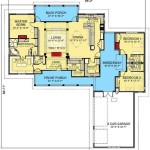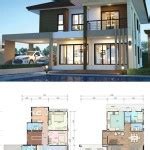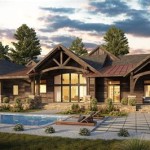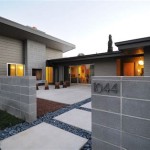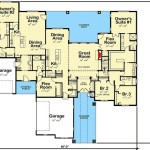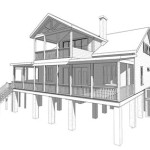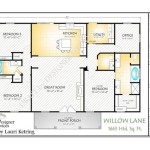French Style House Plans are architectural designs that draw inspiration from historical and traditional French architecture. These plans incorporate distinct characteristics that evoke the charm and elegance of French homes, capturing their essence in modern-day designs. One notable example is the Chteau de Chantilly, a magnificent palace located north of Paris, renowned for its elaborate gardens and stunning Renaissance architecture.
French Style House Plans prioritize symmetry, intricate detailing, and an emphasis on natural light. They often feature high ceilings, large windows, and decorative moldings, creating a sense of grandeur and sophistication. The plans typically include elements such as mansard roofs, dormer windows, arched doorways, and cast-iron balconies, paying homage to classic French design.
In the following sections, we will delve into the key elements and considerations when designing French Style House Plans, exploring their historical context, architectural features, and modern adaptations.
French Style House Plans embody a distinct architectural style with key elements that set them apart:
- Symmetrical facade
- Mansard roof
- Dormer windows
- Arched doorways
- Cast-iron balconies
- High ceilings
- Large windows
- Decorative moldings
- Emphasis on natural light
These elements combine to create a sense of grandeur, sophistication, and timeless elegance.
Symmetrical facade
The symmetrical facade is a defining characteristic of French Style House Plans. It creates a sense of balance and order, giving the house a stately and elegant appearance. The facade is typically divided into three sections: a central section flanked by two wings. The central section often features a grand entrance, with a door flanked by windows on either side. The wings may mirror each other, with matching windows, balconies, or other architectural elements.
The symmetrical facade is not only aesthetically pleasing but also practical. It allows for a more efficient use of space, as the rooms on either side of the central axis can be mirrored, creating a sense of flow and balance throughout the house.
In addition to its aesthetic and practical benefits, the symmetrical facade also has historical significance. It can be traced back to the Renaissance period, when architects began to apply classical principles of symmetry and proportion to their designs. French architects adopted this style and incorporated it into their own designs, creating the distinctive French Style House Plans that we see today.
Overall, the symmetrical facade is an essential element of French Style House Plans, contributing to their timeless elegance, practicality, and historical significance.
Mansard roof
The mansard roof is a distinctive feature of French Style House Plans. It is a four-sided roof with two slopes on each side, the lower slope being steeper than the upper slope. This creates a distinctive silhouette that is both elegant and practical.
- Increased living space: The mansard roof allows for more living space to be created within the attic. This space can be used for bedrooms, offices, or other purposes, increasing the overall functionality of the house.
By incorporating the mansard roof, architects can create homes with more usable square footage without having to build a larger footprint. This makes it a popular choice for homeowners who want to maximize their living space.
- Natural light: The steep lower slope of the mansard roof allows for more natural light to enter the attic space. This creates a brighter and more inviting living environment, reducing the need for artificial lighting.
The large windows that are often incorporated into the mansard roof also contribute to the abundance of natural light. These windows provide stunning views of the surrounding landscape and help to create a connection between the indoors and outdoors.
- Ventilation: The mansard roof also provides excellent ventilation. The steep lower slope allows for air to circulate more easily, preventing the attic space from becoming too hot or stuffy.
In addition, the windows in the mansard roof can be opened to allow for even more ventilation. This helps to keep the house cool and comfortable, even on hot summer days.
- Aesthetics: The mansard roof is a visually appealing feature that adds character and charm to French Style House Plans. It creates a distinctive silhouette that is both elegant and timeless.
The mansard roof can be further enhanced with decorative elements such as dormers, finials, and moldings. These details add to the overall beauty of the home and help to create a unique and inviting facade.
Overall, the mansard roof is a versatile and practical feature that combines functionality with aesthetics. It is a defining characteristic of French Style House Plans and contributes to their timeless appeal.
Dormer windows
Dormer windows are a characteristic feature of French Style House Plans. They are vertical windows that project out from the roof, creating a small room or alcove within the attic space. Dormer windows serve both functional and aesthetic purposes:
- Increased natural light: Dormer windows allow for more natural light to enter the attic space, creating a brighter and more inviting living environment. This reduces the need for artificial lighting and helps to create a more natural and healthy indoor atmosphere.
The large windows that are often incorporated into dormers provide stunning views of the surrounding landscape and help to create a connection between the indoors and outdoors.
- Ventilation: Dormer windows also provide excellent ventilation. They can be opened to allow for fresh air to circulate, preventing the attic space from becoming too hot or stuffy.
This is especially important in warmer climates, where the attic can become uncomfortably hot during the summer months. By opening the dormer windows, homeowners can create a more comfortable living environment in the attic.
- Increased living space: Dormer windows can also be used to create additional living space within the attic. This space can be used for bedrooms, offices, or other purposes, increasing the overall functionality of the house.
By incorporating dormer windows, architects can create homes with more usable square footage without having to build a larger footprint. This makes it a popular choice for homeowners who want to maximize their living space.
- Aesthetic appeal: Dormer windows add character and charm to French Style House Plans. They create a distinctive and visually appealing silhouette that sets these homes apart from others.
The shape and style of dormer windows can vary, from simple rectangular windows to more elaborate arched or gabled windows. These details add to the overall beauty of the home and help to create a unique and inviting facade.
Overall, dormer windows are a versatile and practical feature that combines functionality with aesthetics. They are a defining characteristic of French Style House Plans and contribute to their timeless appeal.
Arched doorways
Arched doorways are a signature feature of French Style House Plans. They add a touch of elegance and grandeur to any home, and they can be used both indoors and outdoors.
- Aesthetic appeal: Arched doorways are visually appealing and add character to any home. They create a sense of movement and flow, and they can make a small space feel larger.
The shape of the arch can vary, from simple semi-circular arches to more elaborate pointed or ogee arches. The choice of arch shape will depend on the overall style of the home and the desired effect.
- Functionality: Arched doorways are also functional. They can be used to create a more open and inviting floor plan, and they can also be used to define different spaces within a home.
For example, an arched doorway can be used to separate the living room from the dining room, or it can be used to create a grand entrance to a master suite. Arched doorways can also be used to add height to a room, making it feel more spacious.
- Historical significance: Arched doorways have a long history in French architecture. They were first used in Romanesque architecture, and they continued to be popular in Gothic and Renaissance architecture.
Arched doorways were also used in the chateaux and manor houses of the French countryside. Today, arched doorways are still a popular feature of French Style House Plans, adding a touch of history and charm to these homes.
- Versatility: Arched doorways are versatile and can be used in a variety of ways. They can be used as exterior doorways, interior doorways, or even as windows.
Arched doorways can also be used to create unique and interesting architectural features, such as arched niches or alcoves. The possibilities are endless.
Overall, arched doorways are a beautiful and functional addition to any French Style House Plan. They add a touch of elegance, grandeur, and history to any home.
Cast-iron balconies
Origins and history
Cast-iron balconies first emerged in France during the 18th century. They were initially used in grand architectural projects, such as the Palace of Versailles. However, they soon became popular in residential buildings as well, particularly in the cities of Paris and Lyon.
Cast-iron balconies were favored for their strength, durability, and relatively low cost. They were also highly decorative, and could be cast in a variety of shapes and styles to suit the taste of the homeowner.
Design and construction
Cast-iron balconies are typically made from a single piece of cast iron, which is then bolted or welded to the facade of the building. They are usually supported by decorative brackets or corbels.
The design of cast-iron balconies can vary greatly. Some balconies are simple and understated, while others are highly ornate and elaborate. Common design elements include scrolls, flowers, leaves, and geometric patterns.
Advantages and disadvantages
Cast-iron balconies offer a number of advantages over other types of balconies. They are strong and durable, and can withstand harsh weather conditions. They are also relatively low maintenance, and can be easily cleaned with soap and water.
However, cast-iron balconies can also be heavy and expensive to install. They can also be susceptible to rust, especially if they are not properly maintained.
Modern applications
Cast-iron balconies are still popular in French Style House Plans today. They add a touch of elegance and charm to any home, and they can be used to create a variety of different looks, from traditional to modern.
Modern cast-iron balconies are often made from lighter and more durable materials, such as aluminum or steel. This makes them easier to install and maintain, and it also reduces the risk of rust.
High ceilings
High ceilings are a defining characteristic of French Style House Plans. They create a sense of grandeur and spaciousness, and they can make a home feel more inviting and luxurious.
There are several advantages to having high ceilings in a home. First, they allow for more natural light to enter the space. This can make the home feel brighter and more cheerful, and it can also reduce the need for artificial lighting.
Second, high ceilings can help to improve air circulation. This can make the home feel more comfortable, especially in warm weather. Third, high ceilings can create a sense of drama and excitement. This can be especially effective in large rooms, such as living rooms and dining rooms.
Of course, there are also some disadvantages to having high ceilings. First, they can make a home more difficult to heat and cool. This can lead to higher energy bills. Second, high ceilings can make it more difficult to reach objects that are stored on high shelves or in the attic.
Overall, the advantages of having high ceilings in a home outweigh the disadvantages. High ceilings can create a sense of grandeur, spaciousness, and luxury. They can also make a home feel brighter, more cheerful, and more comfortable.
Large windows
Large windows are another characteristic feature of French Style House Plans. They allow for an abundance of natural light to enter the home, creating a bright and airy atmosphere. Large windows also provide stunning views of the surrounding landscape, helping to connect the indoors with the outdoors.
- Increased natural light: Large windows allow for more natural light to enter the home, reducing the need for artificial lighting and creating a brighter and more inviting living environment.
Natural light has many benefits for health and well-being. It can help to improve mood, increase productivity, and reduce stress. Large windows in French Style House Plans maximize the amount of natural light that enters the home, creating a healthier and more enjoyable living space.
- Stunning views: Large windows provide stunning views of the surrounding landscape, bringing the outdoors in and creating a connection between the home and its environment.
French Style House Plans are often designed to take advantage of beautiful views, whether it be a lush garden, a sparkling lake, or a rolling countryside. Large windows allow homeowners to enjoy these views from the comfort of their own homes.
- Reduced energy costs: Large windows can help to reduce energy costs by allowing for passive solar heating. During the winter months, the sun’s rays can enter the home through the windows and warm the interior, reducing the need for heating. In the summer months, the windows can be opened to allow for natural ventilation, reducing the need for air conditioning.
- Increased curb appeal: Large windows add to the curb appeal of a home, making it more attractive to potential buyers. A home with large windows looks more inviting and spacious from the outside.
Overall, large windows are a key feature of French Style House Plans. They provide numerous benefits, including increased natural light, stunning views, reduced energy costs, and increased curb appeal.
Decorative moldings
Decorative moldings are a distinctive feature of French Style House Plans. They add a touch of elegance and sophistication to any home, and they can be used to create a variety of different looks, from traditional to modern.
Moldings can be used to accentuate architectural features, such as doorways, windows, and ceilings. They can also be used to create decorative panels and friezes. Moldings are typically made from wood, plaster, or polyurethane.
There are many different types of moldings, each with its own unique profile. Some of the most popular types of moldings used in French Style House Plans include:
- Crown molding: Crown molding is a type of molding that is used to decorate the joint between the wall and the ceiling. It can be simple or elaborate, and it can add a touch of elegance to any room.
- Base molding: Base molding is a type of molding that is used to decorate the joint between the wall and the floor. It can be simple or elaborate, and it can help to protect the wall from damage.
- Chair rail molding: Chair rail molding is a type of molding that is used to decorate the wall at about the height of a chair back. It can be simple or elaborate, and it can help to protect the wall from damage caused by chairs.
- Picture rail molding: Picture rail molding is a type of molding that is used to hang pictures on the wall. It is typically a simple molding, but it can add a touch of elegance to any room.
Decorative moldings can be used to create a variety of different looks in French Style House Plans. For example, simple moldings can be used to create a clean and modern look, while more elaborate moldings can be used to create a more traditional or formal look.
No matter what style you choose, decorative moldings are a beautiful and versatile way to add a touch of elegance and sophistication to your French Style House Plan.
Emphasis on natural light
French Style House Plans place a strong emphasis on natural light. This is achieved through the use of large windows, high ceilings, and open floor plans. Natural light has many benefits for health and well-being. It can help to improve mood, increase productivity, and reduce stress.
Large windows are a key feature of French Style House Plans. They allow for an abundance of natural light to enter the home, creating a bright and airy atmosphere. Large windows also provide stunning views of the surrounding landscape, helping to connect the indoors with the outdoors.
High ceilings are another important factor in maximizing natural light. High ceilings allow for more light to enter the home, even on overcast days. They also create a sense of grandeur and spaciousness, making the home feel more inviting and luxurious.
Open floor plans are also helpful in maximizing natural light. By removing walls and barriers between rooms, open floor plans allow light to flow more freely throughout the home. This creates a more cohesive and inviting living space.
The emphasis on natural light in French Style House Plans is not only aesthetically pleasing, but it is also beneficial for health and well-being. By incorporating large windows, high ceilings, and open floor plans, French Style House Plans create homes that are both beautiful and healthy.










Related Posts

